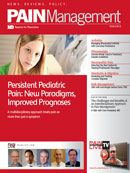Publication
Article
Pain Management
Is it oversight or overreach?
Publisher's note, February 2012.
The complex potential for abuse and misuse inherent in opioid pain medications has created an increasingly difficult-tonavigate practice environment for pain clinicians. Conscientious practitioners attempt to mitigate the risks associated with chronic opioid treatment through careful screening, monitoring, and followup, motivated by concerns for the safety and welfare of their patients and the desire to deliver real pain relief. Given the increased awareness of the true extent of the risk for dependence and addiction that attends the uninformed and indifferent prescription of large amounts of opioids, it seems clear that most clinicians would pursue a cautious and evidencebased prescribing policy based solely on patient safety concerns even in the absence of outside authorities attempting to impose restrictions and conditions on the prescribing of opioids, backed by the threat of financial and legal penalties.
As we all know, however, the arena in which this takes place has expanded beyond the exam room and the interactions between individual physicians and patients. Many other actors exert influence on this particular physician-patient treatment transaction. Faced with the consequences of liberalized prescribing policies (in part the outcome of a decade-long campaign to increase awareness of the problem of widespread undertreatment of pain) and the public’s apparently insatiable appetite for the non-medical use of controlled substances, regulators and law enforcement at all levels have focused unprecedented attention on these medications and the manner in which they are prescribed and dispensed. Rules and regulations promulgated by state medical boards, state and local law enforcement, the DEA, third-party payers (both federal and private), and other entities touch on nearly every aspect of opioid prescribingfrom the physical form of the prescription itself, to the amounts and frequency with which the drugs may be prescribed, to the additional training that some providers must undergo, to the additional expense associated with insuring one’s practice. The result has been a morass of sometimes vague and contradictory statutes and “guidance” that lead to multi-level scrutiny and second-guessing of the clinical decisions of physicians and other prescribers, while enlisting them into efforts to police the habits of their patients and then holding them accountable for patients’ criminal behaviors that are largely out of prescribers’ control.
To a great degree, this push for greater oversight is rooted in a genuine desire to improve patient safety and curb the abuse, misuse, and diversion of opioid pain medications. However, at what point does the exercise of regulatory and monitoring authority based not on clinical expertise, but instead on bureaucratic financial concerns, cross the line into unproductive meddling? At what point does oversight become overreach? A potentially troubling example of this can be seen in the recent series of letters sent to the Medicaid programs in 33 states by the office of US Senator Charles Grassley (http://bit.ly/AmSmvY). The letters asked pointed questions about providers engaged in what was referred to as “excessive prescription writing” of anti-psychotics, anti-anxiety drugs, and pain medications, and what “actions” (if any) the states were taking with respect to these prescribers (http://bit.ly/y1zCHi).
This latest instance of the government inserting itself into the patient-physician relationship and questioning the medical necessity/validity of specific treatment decisions may have a further chilling effect on clinicians who already feel as if they practice under a microscope, convincing more of them to forgo providing pain care altogether. Peter Pitts, founder of the Center for Medicine in the Public Interest, warned of the potential unintended consequences of this “ill-considered” decision “to commence an inquisition into any given physician’s choice of patient care,” and admonished that “doctors should not have their choices for patient care either dictated or influenced by a politician’s hunt for headlines” (http://bit.ly/xeGt0g).
The vast majority of clinicians who treat patients for pain are serious about patient safety and responsible medication prescribing. It’s unfortunate that the actions of a small minority have produced the current environment of suspicion that may end up harming more patients than it helps.
